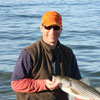Sustainable Fishing Tips: Proper Release
By Tom Keer
Nov 18, 2015
Sustainable fishing isn't just about fisheries management; it's also about properly releasing your fish so they don't go belly up.
Sustainable fishing isn't just about fisheries management; it's also about properly releasing your fish so they don't go belly up. Here are 5 ways to properly release a fish so you can catch them another day.
-
Rock fish back and forth. Hooked fish doesn't know you're going to throw them back, so they fight for their lives. When they do, they build up lactic acid. To properly revive a fish, wet your hands before handling so the protective slime isn't removed. Then, place one hand under its belly, hold its head facing the current, grip its tail, and rock the fish back and forth. Watch its gills to make sure they are pulsing, and when the fish struggles to get away let them go.
-
Keep 'them wet. Removing fish from the water for a picture is cool, but remember that a fish out of water is like holding our heads under water. They can't breathe. Keep the fish under water, lift for a picture, and place back in the water. Survival rates increase dramatically with this method of catch and release fishing
-
Circle hooks for live bait. When fishing live bait, a circle hook is the best idea. Game fish that swallow a bait can get a standard hook lodged in its throat or gills. The design of a circle hook prohibits the bait from being swallowed, and when an angler feels a hit the hook set is in the corner of the fish's mouth.
-
Strong fishing lines. Use the strongest possible braid and monofilament lines so you can quickly fight the fish. The decreased fight time means less lactic acid build up and makes for an easy release. Sometimes light lines are important for catching spooky fish, but if you can get away with 4 pound test instead of 2 pound test you'll get more in the boat and, more importantly, get them out of the boat and back in the water.
-
Jump start certain fish. Some fish could die if you rock them back and forth. Bonito, False albacore, Skipjack and other salty speedsters need to be jump started. After unhooking the fish, place one hand under the belly, grab the tail, and pitch the fish headfirst into the water. The rush of water revives the fish and gets him on his way.
-
Nets and gaffs. Fishing nets with cotton baskets strip the fish's protective slime making them vulnerable to disease. Deep nets with big holes allow the fish's head to slide through and injure their gills. The best bet is a shallow basket nets made from hard rubber or nylon with small holes. Those kinds of fishing nets cradle the fish, keep them from tangling and preserve their protective coatings. Gaffs that land on the side of a fish can kill them which is fine if you're planning on a meal. If you're going to catch and release the fish, run the tip of the gaff under their jaw and through their mouth, and then use a pair of pliers to remove the hook. For big fish use bronzed fishing hooks which rust out faster than stainless and cut the line.
Take care of the fish you release and you'll catch them another day. And on that day they'll be a little bit bigger.









